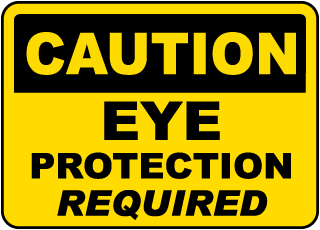Want to prevent 90% of all eye injuries?
All you have to do is wear protective eye wear.
Whether at work or at home, wear eye protection for any activity involving or with the possibility of:
- Hazardous chemicals/fluids/substances
- Debris or particles
- Projectiles
- Blunt trauma
- Sport related injury
Protective eye wear for most activities should have “ANSI Z87.1” marked on the lens or frame, which signifies that it has met the safety standard of the American National Standards Institute (ANSI). ANSI-approved protective eyewear can be purchased at most hardware stores. In general, these should have adequate front and side coverage. For patients who are monocular (has only one eye or only has good vision out of one eye) and wear glasses, lenses should be made of shatter-proof polycarbonate material to prevent globe injury from broken glass.
What should I do if there is eye trauma? (for first- responders)
There are many signs and symptoms that suggest the eye is injured from trauma: eye pain, vision changes, double vision, globe not moving well or appears displaced, abnormal pupil size or shape, blood inside the eye, etc.
Please refer to an ophthalmologist or emergency room provider as soon as possible if there is any concern for eye injury. To avoid delays in care and permanent damage to the eye, patients should be referred to an emergency room that has ophthalmology consultants on call and proper ophthalmology exam equipment. Sinai Hospital of Baltimore emergency room has an ophthalmologist on call 24/7.
Steps that can prevent further damage:
- Don’t touch, rub or apply pressure to the eye.
- Don’t try to remove an object that appears stuck on the surface of the eye or an object that appears to have penetrated the eye.
- Don’t apply ointment or medication to the eye.
- Flush out any chemicals the eye has been exposed to with plenty of clean water.
- Gently place a shield or gauze patch over the eye until you can get medical attention.
- Avoid nausea, vomiting, blowing the nose – the positive pressure can worsen injuries.
Blog post provided by:
Dr. Laura Green
Residency Program Director for Cornea, Cataract and Refractive Surgery Specialties
LifeBridge Health Krieger Eye Institute
Jason Alvarez, M.D.
Third Year Resident
LifeBridge Health Krieger Eye Institute
Maggie Wei, M.D.
Third Year Resident
LifeBridge Health Krieger Eye Institute


